
What tires do muscle cars use to handle all that raw power? With engines pushing 400 horsepower or more, muscle cars demand tires that can transfer that energy to the pavement effectively.
Modern radial tires have changed the muscle car driving experience completely, offering significant improvements in traction, handling, and durability over the bias-ply tires from the golden era. While many classic muscle cars originally came with 14" or 15" wheels from the factory, today's options include everything from period-correct styling to high-performance drag radials.
The Nitto NT555 G2, for example, delivers outstanding performance on straightaways, during corner carving, and when launching from a standstill. For those who split their time between street and strip, specialized options like the NT555RII can handle wet roads on the way to the track and still deliver excellent performance when you arrive. Additionally, many manufacturers now include useful features like Continental's easy-to-read wear indicators that help you monitor your tread life.
From daily drivers with 30,000-mile warranties to dedicated drag radials with large, solid center ribs for maximum launch traction, we'll cover all the best tires for muscle cars in this guide. Whether you're looking for period-correct styling or modern performance, you'll find the perfect rubber to match your muscle car's personality and purpose.
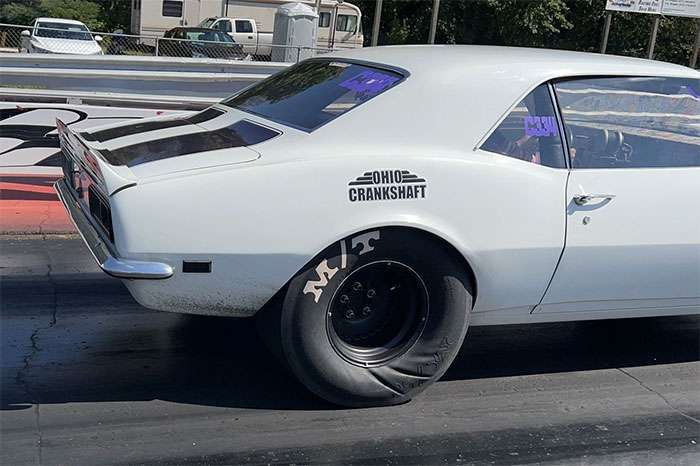
Image Source: Dragzine
Choosing between radial and bias-ply tires for muscle cars isn't just about appearance—it affects how your vehicle performs and handles. The difference between these two tire types goes beyond esthetics and into the engineering that determines grip, comfort, and durability.
The key difference between these tire types lies in their internal architecture. Bias-ply tires feature diagonal cord layers that run at 45-degree angles from bead to bead in a crisscross pattern. This traditional construction, dating back to the early 1900s, creates a rigid structure throughout the entire tire. With each additional layer of overlapping cords, the load rating increases—passenger cars typically used four-ply configurations, while trucks needed six or more plies for additional strength.
Radial tires (introduced by Michelin in 1948) employ a completely different approach. The ply cords run at 90-degree angles to the bead—straight across from one side to the other. Modern radial tires incorporate steel belts beneath the tread surface that enhance stability while allowing the sidewall to remain flexible.
This structural difference is immediately visible: bias-ply tires have squared-off shoulders and typically feature taller sidewalls with narrower contact patches. Radials have more rounded shoulders and wider tread surfaces that create larger contact patches with the road.
The performance differences between these tire types are substantial and immediately noticeable behind the wheel. Bias-ply tires, despite their period-correct appearance, tend to "find the grooves and breaks in the road surface," creating a wandering sensation that can feel unsettling to drivers accustomed to modern tires. This handling becomes even more pronounced with worn suspension components.
Radial tires offer several significant advantages:
Superior handling: Their flexible sidewalls and stable tread area provide better cornering ability and overall stability
Longer tread life: The reduced internal friction and heat buildup extend tire longevity
Improved fuel economy: Lower rolling resistance means better mileage—a primary reason American manufacturers switched to radials in the 1970s
Enhanced traction: The wider contact patch and ability to conform to road surfaces improves grip in various conditions
Greater comfort: Radials absorb road imperfections better, delivering a smoother, quieter ride
The impact of tire choice on quarter-mile performance shouldn't be underestimated. According to track testing, many muscle cars in the 1960s ran high 14s and low 15s in the quarter mile with trap speeds in the high 80s and low 90s mph while running on factory bias-ply tires. Modern radial alternatives often deliver quicker elapsed times due to reduced rolling resistance.
For drag racing applications specifically, bias-ply slicks offer excellent launch characteristics and absorb power better during initial acceleration. Their sidewall wrinkle helps protect the rear axle by absorbing some of the power impact at launch. Radial drag tires keep the vehicle more stable throughout the run and typically require less burnout preparation.
The decision between radial and bias-ply depends on your muscle car's purpose and how you plan to use it.
Bias-ply tires work best for:
Concours-level restorations seeking absolute period correctness
Show cars where authentic appearance matters more than driving characteristics
Traditional hot rods, gassers, and Day 2 muscle car builds that replicate 1950s-1970s esthetics
Certain drag racing applications where their softer sidewall provides better power absorption at launch
Radial tires excel for:
Daily-driven muscle cars that need modern handling and safety
Vehicles driven at highway speeds or for longer distances
Wet weather performance, thanks to better water evacuation through tread siping
Anyone seeking better fuel economy and longer tire life
If you love the classic look but want modern performance, several manufacturers now offer "bias look radials"—tires with modern radial construction but styled to resemble vintage bias-ply tires. These options feature the same vintage profiles with narrow tread patterns and piecrust shoulders but provide the handling benefits of radial construction.
One critical safety note: never mix bias-ply and radial tires on the same vehicle. This dangerous combination creates unstable handling as "the front of the car wants to do one thing while the back does a different dance". Always use matching tire constructions at all four corners.
The major shift from bias-ply to radial tires occurred between 1965 and 1973, with all US automobile manufacturers standardizing on radial tires by 1973. This transition represents one of the most significant technological advances in automotive history, improving safety, efficiency, and driving dynamics for muscle cars and everyday vehicles alike.
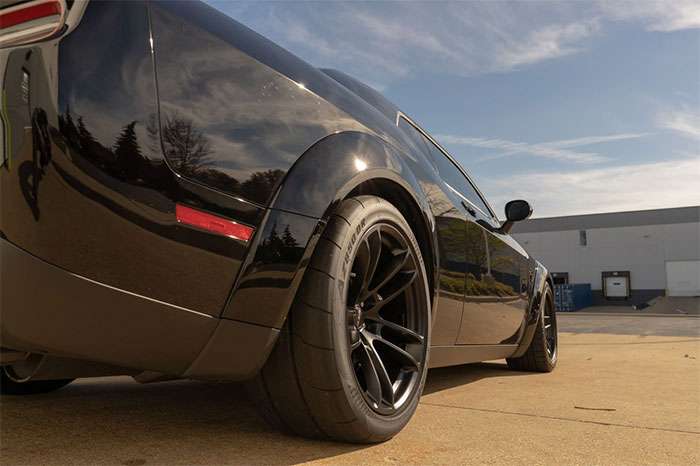
Image Source: Atturo Tires
Drag radial tires represent the perfect middle ground for muscle car owners seeking maximum straight-line performance without sacrificing street drivability. These specialized tires deliver incredible traction at the drag strip yet remain DOT-compliant for the drive home afterward.
Drag radials differ fundamentally from traditional street tires through several key design elements. They feature a much softer rubber compound often rated at "00" treadwear, making them substantially stickier than typical street performance tires. This ultra-soft compound maximizes grip during launch but comes at the cost of shorter lifespan—typically between 3,000 to 5,000 miles of regular driving.
The tread pattern on drag radials is another distinguishing characteristic. Most designs incorporate minimal tread depth, generally between 1/32nd to 5/32nds of an inch compared to standard street tires that start at 10/32nds. This shallower depth, coupled with fewer water evacuation channels, creates a larger contact patch for maximum traction on dry surfaces.
Drag radials feature specialized sidewall construction that balances flexibility with stability. Many incorporate what manufacturers call a "wrinkle wall" design—softer than standard radial sidewalls but considerably stiffer than bias-ply drag slicks. This construction allows the tire to deform slightly at launch, creating a larger contact patch without the extreme sidewall flex of traditional slicks.
The internal architecture of drag radials also differs from both street tires and bias-ply slicks. Their steel-belted construction is significantly stronger than the crisscrossed nylon cords found in bias-ply tires. Mickey Thompson's drag radials, for instance, utilize radial cords running at 90 degrees from the centerline with supporting belts around the tire circumference.
Street performance with drag radials behaves quite differently than at the strip. When cold, these tires can still break loose under heavy acceleration, particularly in first and second gears. However, as they warm up, traction improves considerably—proper temperature management is essential for consistent performance.
At the drag strip, most drag radials benefit from a short burnout to reach optimal operating temperature. Unlike traditional bias-ply slicks that require extensive heating, drag radials need less burnout time to achieve proper temperature. Mickey Thompson recommends heating their tires to within 15 degrees of track temperature for optimal performance.
Drag radials perform best in warm conditions. When temperatures drop between 40 to 60 degrees Fahrenheit, these tires lose much of their stickiness advantage. Their reduced tread depth and minimal water channels make them particularly dangerous in wet conditions, with significantly higher hydroplaning risk than standard street tires.
Handling characteristics also differ between street and track use. On public roads, drag radials sacrifice cornering ability for straight-line traction. Their soft sidewalls don't deliver crisp handling feedback, making twisty roads challenging at higher speeds. Some drivers report that drag radials have a tendency to "snap back" if you get any kind of tire spin or slide going during hard cornering, which can create unpredictable handling.
Air pressure management varies significantly between drag radials and traditional slicks. Where bias-ply slicks might run at 8-12 psi for maximum traction, drag radials typically require 14-17 psi for optimal performance. This higher pressure helps maintain sidewall stability while still allowing sufficient flex for maximum launch traction.
Several manufacturers dominate the drag radial market with products specifically designed for muscle car applications:
Mickey Thompson ET Street Line: The ET Street Radial and ET Street Radial II are among the most respected names in drag racing. The original ET Street Radial is renowned for incredible hook-up, having powered cars to 6-second quarter-mile times. The ET Street Radial II offers better wet weather capability with additional rain grooves while maintaining similar traction. Mickey Thompson's Pro Drag Radials are also popular for competition use, designed specifically for bracket racing with an emphasis on consistency.
Nitto NT555R and NT555RII: The NT555R has been a staple in the muscle car community for years, offering a good balance of street manners and strip performance. With its 100 treadwear rating, it can last around 10,000 miles—making it one of the longest-lasting drag radials available. The newer NT555RII improves upon this formula with increased tread depth and additional water evacuation channels.
Toyo Proxes TQ: This DOT-compliant drag radial features a unique tread design with a semi-slick inner area that improves traction on both independent rear suspension vehicles and solid axle configurations. The Proxes TQ also includes a variable pitch outer area specifically designed to reduce noise when driving on public roads.
BFGoodrich g-Force T/A Drag Radial: As the first drag radial to meet DOT standards, BFG's offering has a storied history in muscle car racing. With its proven 7-second quarter-mile capability, this tire remains popular for street/strip applications. Though still rated at "00" treadwear, the g-Force provides decent rain channel capability for improved wet weather performance.
For modern muscle cars with larger wheel diameters, manufacturers have expanded their offerings. Nitto's NT05R, for example, is available exclusively in 17- to 20-inch sizes to accommodate the larger brake packages found on contemporary muscle cars.
For optimal results, many racers employ a split setup—using drag radials on the drive wheels and matching front tires designed specifically for steering response. Nitto pairs the NT555 G2 for the front with NT555RII drag radials for the rear, combining good handling with maximum launch traction.
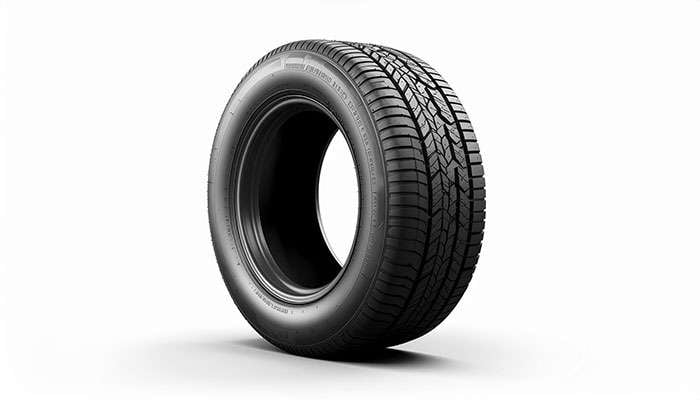
Daily driving a muscle car requires tires that can handle everything from morning commutes to weekend cruises. All-season tires fill this role perfectly, balancing performance with practicality for muscle car owners who want their vehicles to be enjoyable year-round.
All-season muscle car tires are engineered with specialized features that set them apart from dedicated performance or drag options. Most importantly, they're designed to perform across various weather conditions while offering a balanced mix of traction, handling, and fuel efficiency.
The tread patterns on all-season tires feature strategic designs specifically engineered to push water and slush away from the contact patch, enhancing grip on wet roads. Unlike drag radials with minimal tread depth, all-season tires incorporate deeper channels and siping that improves traction in light snow and rain without sacrificing dry performance.
Rubber compounds used in all-season tires strike a middle ground — soft enough to provide respectable handling capabilities in warm weather yet durable enough to maintain flexibility when temperatures drop. This versatility makes them ideal for muscle cars driven throughout the year in changing conditions.
All-season options are manufactured with durability in mind. Many feature specialized construction that extends tread life while maintaining reasonable performance characteristics. If you're seeking an affordable option for your muscle car, all-season tires typically deliver greater longevity and better value over time.
Another key characteristic is their focus on fuel efficiency. The compounds and tread designs create less rolling resistance than stickier performance alternatives. This means you'll experience more wheel spin under hard acceleration and slightly slower 0-60 times, but the trade-off makes sense if your muscle car serves as daily transportation.
Ride comfort stands out as a major advantage of all-season tires for muscle cars. They utilize softer compounds than dedicated performance tires, absorbing road imperfections more effectively and delivering a smoother, quieter ride. This characteristic proves especially valuable on longer drives or commutes where comfort becomes a priority.
Handling characteristics balance everyday drivability with reasonable grip rather than focusing exclusively on maximum cornering ability. This compromise makes them predictable and forgiving in normal driving scenarios.
One limitation involves performance in extreme conditions. All-season tires perform best in mild weather. When temperatures become exceptionally hot or cold, they may experience reduced traction and increased braking distances. In heavy snow conditions, dedicated winter tires would provide superior performance.
For muscle car owners concerned about maintaining control of their high-horsepower vehicles, quality all-season tires offer decent grip without the twitchy characteristics of ultra-high-performance alternatives. Their balanced approach to handling makes them more forgiving and predictable for everyday use.
Several standout models have earned reputations as excellent all-season options for muscle cars:
Cooper Cobra Radial G/T All-Season offers a perfect blend of performance and nostalgic styling. These tires feature raised white lettering on one side and an aggressive cobra design on the other, allowing owners to choose their preferred aesthetic. Beyond looks, they deliver responsive handling and all-season capabilities with their optimized tread compound. Their special void ratio maximizes road contact for enhanced braking and cornering while their notched, solid-center rib promotes even wear.
BFGoodrich Radial T/A All Season represents another excellent choice, particularly for muscle car enthusiasts seeking reliable performance across various conditions. Their durable construction ensures long-lasting performance while providing excellent traction in all weather conditions. The classic tread design enhances aesthetic appeal while still contributing to performance, making them popular among vintage and modern muscle car owners alike.
Falken SN358 A/S provides all-season performance in vintage sizing with chrome classic styling. These tires strike an excellent balance between period-correct appearance and modern performance characteristics, making them ideal for restored muscle cars that see regular use.
Yokohama AVID Ascend LX delivers supreme comfort without sacrificing response and control. For muscle car owners who prioritize a smooth, refined driving experience without giving up reasonable handling capabilities, these tires present an excellent option.
General G-MAX AS-05 and Dunlop Direzza DZ102 have gained popularity among daily drivers seeking classic muscle car aesthetics with modern all-season performance. Their contemporary engineering provides enhanced wet and dry traction while maintaining reasonable tread life for everyday use.
Muscle car owners might hesitate to choose all-season tires over more aggressive options. However, their versatility makes them ideal for vehicles that see regular use across changing seasons. Most factory muscle cars now come equipped with all-season tires because they provide good ride quality regardless of weather conditions or road surfaces.
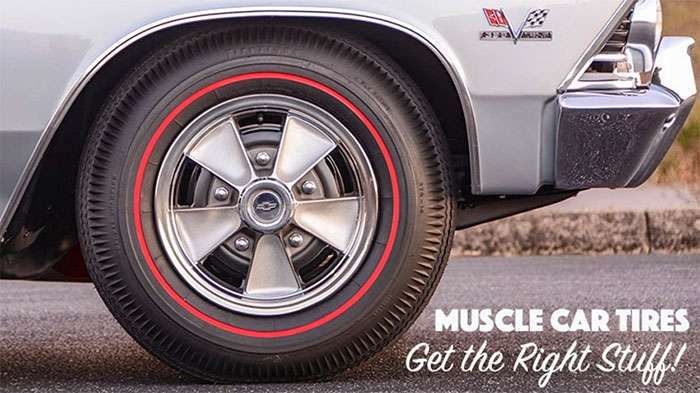
Image Source: Coker Tire
The distinctive visual appeal of vintage rubber remains a crucial element for muscle car enthusiasts seeking authenticity. Period-correct tires create that perfect finishing touch, transforming your muscle car from merely powerful to genuinely nostalgic.
Classic muscle car tires offer a rich variety of styling elements that defined specific eras. Redline tires stand as true icons of the 1960s and early 1970s muscle car era, featuring that distinctive red stripe running along the sidewall. These muscular bias-ply redlines became synonymous with the horsepower wars that dominated American performance culture. For Ford Mustang owners from the 1960s, dual redline tires offer an even more distinctive look with two parallel red stripes enhancing the sidewall appearance.
Whitewalls represent another classic styling option with variations including:
Traditional whitewalls with clean white bands
"Pie crust" style whitewalls featuring distinctive curving edges
Wide whitewalls measuring up to 4 inches for 1950s-era classics
For Corvette owners, goldline tires provide that authentic touch of distinction. These bias-ply options feature golden sidewall stripes that perfectly complement classic Corvettes, available in both 14 and 15-inch sizes. Less common but equally striking, blueline tires like the BF Goodrich 775-14 create another distinctive period-correct option.
Raised white letter tires became the defining look for muscle cars of the late 1960s and early 1970s. These bold sidewall designs featured manufacturer names and tire specifications prominently displayed, creating an aggressive appearance that matched the growing performance capabilities of these vehicles. The Firestone Wide Oval with its raised white lettering remains one of the most recognizable muscle car tires ever produced.
The challenge with classic muscle car tires involves balancing authentic appearance with modern driving expectations. Pure originality often comes with performance compromises—the skinny, ancient tires of the muscle car era were actually one of the biggest factors holding back quarter-mile times and everyday handling.
Today's manufacturers have solved this dilemma through innovative approaches. Companies like Coker Tire pioneered "bias-look radial" construction in 2013, enabling enthusiasts to enjoy authentic bias-ply appearance with modern radial engineering hidden inside. These specialized tires use premium materials including full-silica tread compounds that deliver heritage styling alongside improved safety performance.
The choice between tire types ultimately depends on how you plan to use your vehicle. For show cars and concours-level restorations, bias-ply tires maintain absolute period correctness. Experienced mechanics note that purists demanding 100% authenticity typically choose bias-ply tires for vehicles built before 1975.
Drivers who prioritize handling and performance overwhelmingly select radials. These modern options flex better, allowing superior road surface contact while offering longer tread life, improved handling, better traction, and enhanced stability.
Several manufacturers have established themselves as leaders in the classic muscle car tire market:
Coker Tire stands as the premier supplier of vintage-style tires, offering the most extensive line of authentic options in the world. Their flagship products feature genuine whitewalls integrated during manufacturing (not painted on afterward) while achieving the highest T-speed rating (118 mph) available in any whitewall design. Coker specializes in period-correct reproductions including the legendary Firestone Wide Oval bias-ply tires and various redline, blueline, and goldline options.
BFGoodrich brings American performance heritage to the classic tire market with their racing legacy dating back to 1970. The Radial T/A remains their flagship product, specifically engineered for muscle cars with g-Wedge technology featuring high modulus sidewall stabilizers that enhance lateral stability while maintaining comfortable ride quality. The iconic raised white lettering on the Radial T/A has become synonymous with American muscle cars and hot rods.
Firestone's Wide Oval stands as the definitive muscle car tire from 1967-1973, establishing the performance look of that era. These tires, now reproduced with modern materials, maintain the aggressive stance that muscle car enthusiasts crave.
Other notable options include Vredestein Sprint Classic (earning professional respect since 2001), Michelin's Classic lineup with period-appropriate styling, and Pirelli CN36 which marked their first steel radial tire development in 1968.
The investment in quality classic muscle car tires varies significantly, with prices ranging from approximately USD 72.00 to over USD 330.00 per tire depending on brand and specifications. This price range reflects the specialized nature of these products and their importance to maintaining both the appearance and value of classic muscle cars.
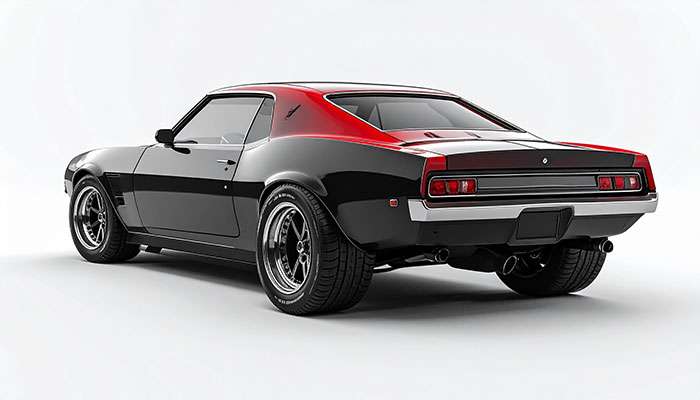
The aggressive, rear-heavy stance of classic muscle cars often comes from staggered fitments — a setup where rear wheels and tires are wider than those up front. This distinctive look isn't just about esthetics; it serves a crucial performance function for high-horsepower vehicles.
Understanding sizing systems becomes essential when selecting muscle car tires. Most muscle cars from the 1960s originally used numeric sizing like "775-15" or alphanumeric codes like "F70-15" before transitioning to today's metric system (e.g., 255/60R15).
Muscle car tire sizing must factor in several crucial elements. Maintaining proper overall diameter keeps speedometer readings accurate and preserves your car's effective gear ratio. Stay within 3% of original diameter to avoid affecting handling, ground clearance, and braking distances.
Muscle cars can handle considerably wider wheels and tires than originally equipped. "Plus 1" or "Plus 2" upgrades increase wheel diameter by 1-2 inches while reducing sidewall height proportionally, maintaining overall tire height while gaining improved appearance and handling.
Staggered setups provide numerous advantages for rear-wheel drive muscle cars. Installing wider tires on the drive wheels creates a larger contact patch where it matters most. This improved grip results in faster acceleration, better cornering stability, and enhanced braking performance.
The larger rear wheels effectively tilt the vehicle forward slightly, shortening turning radius and subtly affecting weight distribution. Keeping front tires narrower reduces rolling resistance, improves turn-in response, and decreases unsprung weight.
Staggered fitments deliver that classic muscle car stance — muscular in the rear with a slightly raked appearance. This look has become synonymous with American performance, visible on everything from classic Mustangs to modern Challengers.
Selecting proper muscle car tire sizes requires careful consideration. Begin by understanding the "tread width" rather than simply relying on the sidewall size marking — brand variations can make a "275" tire as wide as another manufacturer's "305".
For optimal handling, aim for wheel width matching the tire's tread width or slightly wider. This creates ideal sidewall loading — too narrow causes excessive preload and unpredictable break-away characteristics, while too wide produces sloppy handling.
Always test-fit wheels before mounting tires. Clearance issues with brakes, suspension components, and fenders represent common pitfalls in muscle car tire sizing. Proper fitment means tires clear everything when turning or going over bumps.
Understanding the differences between muscle car tire types helps you make the right choice for your specific needs and driving style. This comparison covers the key characteristics, benefits, and limitations of each option.
| Tire Type | Primary Use | Key Features | Performance Characteristics | Notable Examples/Brands | Advantages | Limitations |
|---|---|---|---|---|---|---|
| Radial Tires | Daily driving, modern performance | 90-degree ply cords, steel belts, rounded shoulders | Better cornering, stable handling, wider contact patch | Not specifically mentioned | Superior handling, longer tread life, better fuel economy, enhanced traction, greater comfort | Higher cost than bias-ply |
| Bias-Ply Tires | Show cars, period-correct restorations | 45-degree diagonal cord layers, squared-off shoulders, taller sidewalls | Tends to follow road grooves, softer sidewall flex | Not specifically mentioned | Better power absorption at launch, period-correct appearance | Shorter tread life, wandering sensation, less stable handling |
| Drag Radials | Strip performance, street-strip use | Ultra-soft compounds, minimal tread depth, specialized sidewall construction | Excellent straight-line traction, moderate street handling | Mickey Thompson ET Street, Nitto NT555R, Toyo Proxes TQ | Maximum launch traction, DOT-compliant, good strip performance | Short tread life (3,000-5,000 miles), poor wet weather performance |
| All-Season Street Tires | Daily driving, year-round use | Deep tread channels, balanced compound, water evacuation design | Balanced handling, good wet/dry traction | Cooper Cobra Radial G/T, BFGoodrich Radial T/A, Falken SN358 A/S | Better durability, comfort, all-weather capability | Less maximum performance than specialized tires, compromised extreme weather performance |
| Classic Styled Tires | Show cars, restorations | Redlines, whitewalls, raised white letters | Varies by construction type (bias or radial) | Coker Tire reproductions, Firestone Wide Oval, BFGoodrich Radial T/A | Period-correct appearance, vintage styling options | Higher cost, may sacrifice modern performance for esthetics |
Choosing the right tires for your muscle car depends on how you plan to use your vehicle. Radial tires offer superior handling, better fuel economy, and longer tread life for daily drivers, while bias-ply options maintain that period-correct look for show cars and restorations. Drag radials provide that perfect middle ground for enthusiasts who split their time between street and strip, delivering incredible straight-line performance while remaining street-legal.
Many muscle car owners face the decision between authentic styling and modern performance. Companies now offer "bias-look radials" that combine vintage appearance with contemporary engineering. This innovation allows you to enjoy that classic muscle car appearance without sacrificing safety or handling.
Staggered fitments create both the aggressive stance and functional benefits muscle cars need, particularly when putting massive horsepower to the pavement. The wider rear tires provide essential traction while narrower front tires improve steering response and reduce weight.
Whether you're restoring a classic Mustang to concours-level perfection or building a modern Challenger for weekend drag racing, tire selection remains one of your most important decisions. Your choice affects everything from quarter-mile times to everyday drivability. Get the best prices on your next set of muscle car tires by researching options that match both your vehicle's requirements and your driving style.
Tire technology has changed dramatically since the golden era of American muscle, yet manufacturers continue developing products that honor that heritage while incorporating modern performance features. Finding the perfect balance between nostalgia and capability ensures your muscle car looks right, performs well, and delivers the driving experience you crave.
Understanding muscle car tire options helps you match rubber to your driving style and performance goals, from daily commuting to weekend drag racing.
Radial tires deliver superior handling and longevity - Modern radials offer better cornering, fuel economy, and tread life compared to period-correct bias-ply options for daily-driven muscle cars.
Drag radials bridge street and strip performance - DOT-compliant drag radials provide maximum launch traction for quarter-mile runs while remaining legal for street driving, though they sacrifice wet weather capability.
All-season tires balance performance with practicality - For year-round muscle car driving, all-season options provide reliable traction across weather conditions with enhanced comfort and durability.
Staggered fitments optimize power transfer - Wider rear tires create larger contact patches for better acceleration and traction, while narrower fronts improve steering response and reduce weight.
Classic styling doesn't require performance sacrifice - "Bias-look radials" combine vintage esthetics like redlines and raised white letters with modern radial construction for the best of both worlds.
The key is matching tire choice to your muscle car's primary purpose - whether that's show-quality restoration, daily transportation, or weekend strip domination. Modern tire technology allows you to maintain that classic muscle car look while enjoying contemporary safety and performance benefits.
For daily-driven muscle cars, all-season radial tires offer the best balance of performance and practicality. They provide good traction in various weather conditions, longer tread life, and improved fuel economy compared to vintage bias-ply tires. Popular options include the Cooper Cobra Radial G/T and BFGoodrich Radial T/A.
Drag radial tires feature ultra-soft compounds, minimal tread depth, and specialized sidewall construction for maximum straight-line traction. They provide excellent launch grip and strip performance while remaining street-legal. However, they have shorter tread life (3,000-5,000 miles) and poor wet weather performance compared to regular street tires.
A staggered setup with wider rear tires creates a larger contact patch for improved acceleration and traction. The narrower front tires enhance steering response and reduce weight. This configuration also delivers the classic muscular stance associated with high-performance vehicles.
Modern radial tires offer superior handling, longer tread life, and better fuel economy compared to vintage bias-ply tires. Advanced rubber compounds and tread designs provide enhanced grip in various conditions. Some manufacturers even offer "bias-look radials" that combine vintage esthetics with contemporary performance.
When selecting tire sizes, maintain proper overall diameter to preserve speedometer accuracy and effective gear ratios. Stay within 3% of the original diameter to avoid affecting handling and braking. Consider "Plus 1" or "Plus 2" upgrades to increase wheel diameter while reducing sidewall height proportionally for improved appearance and handling.